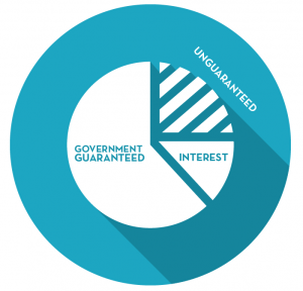Stephen Covey, in his book The 7 Habits of Highly Effective People, discussed the importance of beginning with the end in mind. This is particularly appropriate when considering the best structure for a government-guaranteed loan that will be sold on the secondary market.
For a community bank to be successful in the government-guaranteed lending arena, it is important for the government-guaranteed loan department to be one of the most profitable departments in the institution.
Whether conventional or guaranteed, loans to small businesses default at higher rates than those to medium or large-sized businesses. The SBA tracks its default rates by a variety of criteria. During any given year, excluding severe recession years (ex: 2008-2010) about 3% of the outstanding debt to the SBA will go into default.2 For most community banks, this level of risk is unprecedented – it is LendXP’s experience that community lenders aim to keep their default rates in the 1% range. To compensate for the potential risk of default when making a loan to a small business, knowing how to structure a government-guaranteed loan for sale on the secondary market can make a significant difference.
How structuring of government-guaranteed loans can lead to more profitability:

The additional profit necessary to make the government-guaranteed lending department successful can be derived from the premium received from the sale of the guaranteed portion of the loan, as well as the interest the bank receives on the unguaranteed portion of the loan.
The premium received by the bank can be fully taken into income in the year it is received. Currently, if the loan is properly structured, that premium can be between 10% and 18% of the dollar amount of the sold guaranteed portion of the loan.3 This, along with the interest received – WSJ Prime Rate + 2.75%, (currently 6%) – has the potential to make the loan one of the most profitable loans in the commercial lending department. This is because only the unguaranteed portion remains on the bank's books, only the unguaranteed portion of the asset is utilized by the bank, and only the unguaranteed portion of the asset has an interest cost, risk, and loan loss reserve associated with it.
The premium a bank receives on the sale of the government-guaranteed portion of a loan tends to be driven by two things:
-
The interest rate spread above the WSJ Prime Rate; and
-
The term of the loan.
In most instances, a higher interest rate spread and a longer loan term equate to a higher sale premium received by the lender when the loan is sold.
To maximize profit, all government-guaranteed loans should start at the maximum rate (WSJ Prime Rate plus 2.75%) adjusted on a calendar quarter. In rare instances, the bank may need to lower the rate, but only when there is ample documentation supporting such a decision. A small reduction in rate (1%) can have a dramatic reduction in the premium received (-37%). The same is true for the term of the loan. A reduction of the term of the loan from 10 years to 7 years reduces the premium by 43%.4 Couple those two negatives together, a reduction in rate and term, and you can reduce anticipated premiums by more than 70%!
Since the government-guaranteed loan department should ideally be one of the most profitable departments in the bank, when discussing lending with a borrower, it is important, to begin with, the end in mind. Assuming the lender’s intention is to sell every guaranteed loan and the goal is to maximize profitability to offset the risk of higher defaults, the borrower should be informed as to why the rate needs to be WSJ Prime Rate + 2.75% and why the term needs to be at least 10 years. When the lender begins the initial dialog with a borrower and keeps these goals in mind, they can overcome the rate and term objections long before they are ready to ask the borrower to do business.
If you have questions on how your bank can benefit from government-guaranteed loans, the team at LendXP is ready to help.
1 Covey, S. R. (1989). The 7 Habits of Highly Effective People. 1989, NY: Free Press.
2 Mills, Karen G. “SBA Responses to Letter from Senator Risch.” Small Business Administration, 19 Feb. 2013. Web.
3 “Charge-Off and Delinquency Rates on Loans and Leases at Commercial Banks.” Federal Reserve. FDIC, 18 Feb. 2015. Web.
4 Raymond James. “SBA MARKET INDICATIONS FROM RAYMOND JAMES, 3/2/2015.” 02 Mar 2015. E-mail.;
Barnes, David. “Stifel SBA 7(a) Bid Grid – February 2015.” 02 Feb. 2015. E-mail.